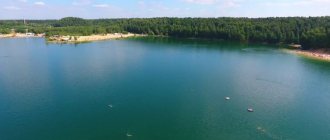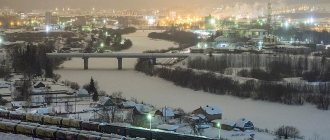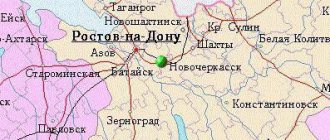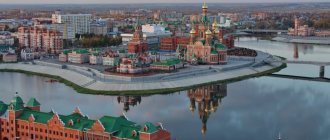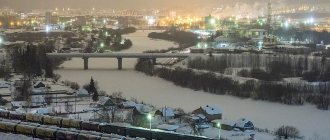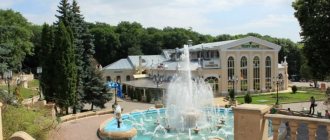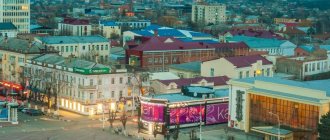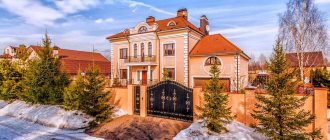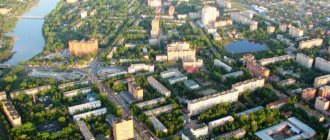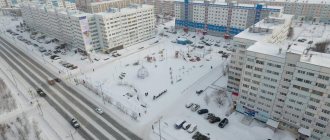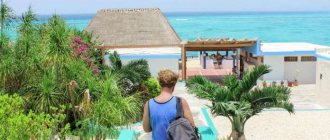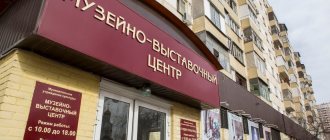It is generally accepted that Soviet architecture is monotonous and boring. This is especially true about the residential areas of the late USSR, with their poor planning and landscaping, shabby walls and poor entrances.
But Soviet architecture is different. Where the project was influenced not only by foremen, but also by architects, there are interesting solutions. For example, in the city of Protvino - a science city a hundred kilometers south of Moscow, which literally stands in the middle of a forest. Now its residents are trying to save their historical heritage from poor amenities and a “comfortable urban environment.”
Protvino
One of the young cities of the Moscow region, Protvino , was founded on the left bank of the Protva River near its confluence with the deep and navigable Oka.
The urban settlement located in the south of the region is located 95 kilometers from Moscow. In the west, the borders of Protvino pass next to the Zhukovsky district in the Kaluga region. Its eastern part borders on the Dashkovsky settlement, which belongs to the Serpukhov district. In the south, along the Protva River there are borders with the Tarussky district in the Kaluga region. Protvino Bal was originally founded as a working village in 1960, when construction of a proton accelerator began in these places, which until 1972 was the largest device in the world. The then small village got its name from the Protva River.
To carry out the necessary research, the Institute of High Energy Physics was created on its territory in 1963, which is currently a major scientific center in the country. In 1989, the village was transformed into a city.
The 90s of the last century brought economic decline to the city. The reduction in funding for scientific programs resulted in the suspension of the work of enterprises and the institute. Some scientists were forced to leave Protvino due to lack of work.
In the summer of 2008, the city was awarded the status of a science city of Russia based on a government decree. Currently, prosperous Protvino is the scientific center of the country; numerous enterprises in the food, furniture, electrical industries and a number of other modern industries operate successfully here. A technology park and a technical center with a business incubator are actively operating.
Some of the local attractions are: a former sand quarry, which is currently an artificial lake, the remains of the merchant Bobrov's water mill, built in 1872, and a suspension bridge over the Protva River.
Source
House of Culture "Proton"
The Palace of Culture was built according to a standard design. Although similar buildings were built throughout the USSR, only a few have survived to this day in good condition. Proton was in almost perfect condition a year ago, but then reconstruction began. Residents protested, but were unable to stop the destruction of the external and internal appearance.
Fortunately, it was possible to preserve the unique mosaics - the first joint work of artists Eleonora Zharenova and Vladimir Vasiltsov. They are famous for their work “Möbius strip” or “Ear” on the facade of the building of the Central Institute of Economics and Mathematics of the Russian Academy of Sciences. The mosaic is the most valuable monumental composition in the city. She was put under guard.
Protvino
Protvino
- a city (since 1989) of regional subordination in the Moscow region.
The population of the city is 37.3 thousand inhabitants (2010).
The city is located in the south of the region, on the left bank of the Protva River, near its confluence with the Oka, approximately 15 km west of Serpukhov and 95 km south of Moscow. In the east it borders with the Dashkovsky settlement of the Serpukhov municipal district, in the west with the Zhukovsky district of the Kaluga region, and in the south along Protva with the Tarussky district of the Kaluga region. Since August 18, 2008, it has the status of a science city of Russia.
Separation of cars and pedestrians
The second half of the 20th century was a time of urban planning experiments all over the world. Many city planners tried to create a garden city, to make personal cars and pedestrians friendly, and assigned strict functions to the districts (sleeping, administrative, production, etc.). The same applied to traffic flows: the architects dreamed of separating cars and everyone else. Some ideas were even implemented, for example, you can remember the Barbican in London:
Soviet architects did not know the problem of a mass-produced car, but they wanted to do it like everyone else. In Protvina, they decided to build a ring highway, buried relative to other streets, and make the old streets completely pedestrian. Cars had to go straight into underground garages, and motorists into their apartments, bypassing the streets. The project suffered greatly due to the high cost; only a small part was completed.
Such ideas existed all over the world, the USSR was no exception. And everywhere architects faced one problem - there was not enough money. Thus, in Protvina, officials gradually proposed abandoning various elements of the project until it died. They managed to complete one section of the deepened route, but the pedestrian bridges were never completed. Now people have to go down and cross the buried zebra crossing.
A small section of the pedestrian alley remains behind the house as a monument to these ideas.
Story
The name Protvino comes from the Protva River. It was founded as a workers' village simultaneously with the start of construction of the proton accelerator in 1960. This huge scientific instrument was the largest in the world until 1972.
Initially, the new settlement was named after its postal code - Serpukhov-7
and was a secret object, not indicated on the map or road signs, access to which was possible only with a pass. On January 22, 1965, the status of an urban-type settlement was received and a new name (derived from the name of the Protva River) - Protvino.
In 1963, the Institute of High Energy Physics was organized to conduct research, which today is one of the largest physical research centers in Russia and, in fact, the city-forming enterprise of Protvino.
In Protvino, greenhouse conditions were created for the living and work of Soviet and foreign physicists: housing of improved series was built, stores were supplied with products and things unavailable in most other regions of the USSR, a house of scientists operated, in which stars of the Soviet stage, theater and movie.
In 1989, the urban-type settlement of Protvino was transformed into a city of regional subordination.
In the 1990s, due to a sharp decrease in government funding, IHEP’s scientific programs were curtailed, and the work of factories serving the institute and defense orders was paralyzed. Many scientists emigrated. The scientific potential of the city was lost.
On August 18, 2008, by Decree of the Government of the Russian Federation No. 624, the city of Protvino was awarded the status of a science city of the Russian Federation.
Soviet interiors
In Protvino, like in any science city, there is a hotel. Scientists stayed here and events were held. There are two buildings here, one was built for Soviet guests, the other for foreign ones.
From the street, the hotel building seems typical, but inside you feel like you have moved back 40 years.
The atmosphere is influenced by the preserved interior and details. This preservation is very easy to explain: the hotel is departmental and there was simply no money for a turnkey European-quality renovation. Poverty saved beauty:
Today there are almost no such interiors left. Once upon a time, all this was not valued and was taken to a landfill.
There are even ventilation niches that could be opened for additional ventilation! Although most often they are filled with garbage.
Unfortunately, they managed to carry out repairs on several floors, and all this was lost.
Industry
Today Protvino is not only a scientific center. The city operates small and medium-sized food enterprises (OJSC Protvinsky Meat Processing Plant, OJSC Mikoyanovskaya Sloboda), furniture (OOO PKF Yantar), electrical engineering (OJSC Protvinsky Experimental Plant Progress) industries; enterprises for the development of software (ZAO "RDTEKH"), computer television security systems (LLC "New Technologies"), production of automotive components (ZAO "NPO Turbotekhnika"), production of polymer geogrid "ST" (LLC "Dialog ST").
The high-tech products of the enterprises LLC NPO DNA-Technology, CJSC Rentgenprom, LLC VEDA, and CJSC Protom are known not only in Russia, but also abroad. These enterprises have repeatedly received prizes and diplomas at Russian and foreign exhibitions.
Since 1994, the Serpukhov Chamber of Commerce and Industry has been active in the region.
The city has support structures for small and medium-sized businesses: a technology park and a technology innovation center with a business incubator.
Smart sidewalks and stupid landscaping
Every city in Russia has the problem of trampled paths. This is a mistake in planning and improvement, but we would rather blame the townspeople themselves for walking incorrectly than admit the mistake. And then they surround the paths with fences, turning yards into cemeteries. But not in Protvina!
Here the architects did not lay out paths through the courtyards and streets in advance. After settling in the houses, people trod out convenient paths for themselves, and the architects laid concrete slabs there. They go around trees and do not interfere with their growth, rising up if necessary. In addition, there is no problem of puddles here: everything flows into the cracks and soil. In general, the slabs have become a feature of the entire city and form its uniqueness.
This solution has one drawback - the slabs are floating, no one has leveled them since they were built.
Instead of simply replacing the dead slabs and pouring sand under the base, they began to throw out the slabs and pave everything. The quality of implementation suffers, which is why the city loses not only its face, but also its functionality.
The peculiarity of the slabs is that they are simply laid on top without tearing out the foundation. When asphalt paths are laid, curbs and a recess into the ground are needed. In general, for the sake of repairing roads, they simply began to cut down the roots of trees. Such improvement will not cause trees to fall immediately, but this often leads to illness, which already leads to the risk of death and falling. Such improvement destroys the city's ecosystem.
Problems with the destruction of Soviet amenities began back in the 1990s: unique playgrounds are being demolished and standard ones that look like mountains of plastic are being installed.
Some remain in ruins or only isolated elements. Residents of Protvino launched a major campaign against the destruction of the heritage of Soviet architects. They call for public improvement competitions to be held so that residents can decide how the city will change.
In general, the plastic-asphalt world won. Was:
Became:
Walk around the city of Protvino: “Broadway” of physicists, “sea” and “Border of Defense”
The church was built in the style of temple architecture of Moscow Rus' of the 15th-16th centuries. Some note that the church resembles Armenian-Gregorian architecture, but, according to the rector, this is exactly what the oldest Pskov-Novgorod churches were like. In the Protvina church there is a rather rare icon of the martyr Uar, to whom people pray for unbaptized loved ones and infants.
In 2010, on the territory of the city church, a water-blessed baptismal place with a font was built, where everyone can undergo the rite of baptism in full rite, perform ablution and draw holy water.
"Anthills" on Broadway
An interesting residential development on Lenin Street, which locals call “Broadway”.
The buildings along this street form a beautiful ensemble because they were built according to individual architectural designs, unusual for typical residential buildings of the 70s. Many of them have a special shape and layout. Two other residential buildings are called "saw" for their shape, creating a jagged line. Apartments in such houses are two-story, with stairs.
Corn houses are multi-story red brick towers with small rounded balconies that look like grains from the outside.
"Line of Defense"
During the Great Patriotic War, Protvino was on the line of defense of Moscow.
In 1983, on the southern outskirts of the forest, where units of the 194th Infantry Rechitsa Red Banner Division fought in the fall of 1941, one of the main monuments of the science city, the “Frontier of Defense” memorial, was inaugurated. This is a large architectural ensemble of objects of military-historical and patriotic heritage. At the entrance to the memorial there is a memorial stele made of red brick, to the right of it in the forest is the restored position of the rifle squad of the 470th rifle regiment with trenches, dugouts and a blocked gap.
In 2010, an alley of equipment and weapons from the Second World War was opened on the territory of the memorial. Initially, the turret of a T-34-76 tank from the 1940s, which was brought from a military unit, and a concrete cap of a long-term firing point (pillbox), discovered by searchers in one of the forest clearings, were located here. And in 2015, for the 70th anniversary of the Great Victory, four more units of front-line equipment were installed on the alley: the PM-38 regimental mortar, the D-44 85 mm divisional gun, the M-38 howitzer and the D-37 anti-aircraft automatic gun.
The quarry has become a favorite vacation spot not only for Protvina families, but also for residents of other cities in the region. Here you can just stroll, swim, sunbathe, play sports, and take pictures. In summer, kids love to sit in the paddling pool. And the guys from local sports camps train on the banks of the quarry in the summer.
— by bus No. 363 Moscow-Protvino from the Yuzhnaya metro station
— by bus No. 483 Moscow-Protvino from the Yugo-Zapadnaya metro station
— by electric trains of the Kursk direction of the Moscow Railway to the Serpukhov station, then by bus Serpukhov-Protvino
- by personal vehicle along the M-2 Moscow-Crimea highway, through Serpukhov and further along the main road through the settlements of Bolshevik, Dashkovka, Kalinovo before entering the city of Protvino.
Source
City Civic Center
The street from the theoretical building of the institute leads to the public center. Here, around Mirabell Square, there is a hotel, the Proton recreation center and a shopping street. The square was named after the French bubble chamber: it was brought to the city in the early 1970s for research, and they decided to immortalize this event in the toponymy of the city.
On the first floors of the central street, places for trade were created; now it would be called a pedestrian shopping boulevard:
The sidewalk is hidden from the road by a dense green wall of trees and bushes - you can hardly hear cars here:
All logistics were placed underground so that trucks did not deliver goods through courtyards and sidewalks: they went down to the underground floor and unloaded there. Similarly, by the way, business operates in the book-houses of Moscow's New Arbat.
Nowadays, ground floor trade and logistics are a sore subject. Trucks and gazelles arrive late in the evening or early in the morning, make noise, create extraneous traffic in the yard, which leads to conflicts. Only now have some developers realized that this is a problem. Therefore, they began to build a special large garage where the gazelle could drive in. That is, they solved the problem, but on a smaller scale.
New development in Cheboksary
The wall of the entrance to the underground floor was decorated by artist Valentin Pomelov with colored panels. Layers of colored plaster were successively applied to the wall to create a pattern. A few years ago, the wall was painted over with white paint because the panel began to crack. In the image you can see the outline of a peacock with seven feathers. The panel reminds that for the first four years Protvino was called Serpukhov-7, since the coat of arms of Serpukhov also depicts a peacock.
